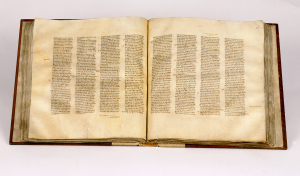
The Codex Sinaiticus, a handwritten Greek manuscript written in the middle of the fourth century. It is the earliest existing complete copy of the New Testament.
“Don’t you know that the New Testament is full of errors? Over the years, scribes made copy after copy, and introduced so many alterations, errors, and variations that today we can’t even be sure what the original texts said! In fact, scholars have shown that the surviving manuscripts have around 400,000 variations. That’s a horrible number, especially considering that the entire New Testament only has about 138,000 words!”
The argument above is made repeatedly by those who want to tear down the New Testament. Recently, New Testament scholar, Bart Ehrman boosted the argument in his book, Misquoting Jesus: The Story Behind Who Changed the Bible and Why. It continues to be repeated, ad infinitum, by anti-Christian bloggers, professors, and others. So, what’s the truth about it?
First, it might be helpful to read an earlier article in Logic & Light on this topic, Has the New Testament Been Reliably Passed Down to Us? It provides some important background information regarding the New Testament and the number of ancient Greek manuscripts we currently have in our possession.
To make a long story short, we have about 5,800, written at different times and in different places, which can be used to cross-check one another for accuracy. That is far more copies than we have for other great works of literature, often by many orders of magnitude. Having such a wealth of ancient copies available, even if many are fragmentary, provides a wealth of data for scholars to use as they determine the wording of the original texts.
Now, let’s explore this business about 400,000 variations in a document with only 138,000 words. Remember that a variation is basically defined as a difference from an established standard text, no matter how small or insignificant. These can be as minor as spelling variations (akin to “flavor” vs. “flavour”) or as major as a total rewrite of a passage.
It is true that about 400,000 textual variations exist, if one counts across all 5,000 ancient texts available to us. This abundance of ancient texts is a great thing, and it’s that abundance that results in so many variations. If we only had one or two copies available, then we’d have very few variations. It’s important to note, however, that these variations do not actually impair our ability to determine what the original text said, or to determine its meaning.
Biblical manuscript expert, Daniel Wallace, has characterized New Testament variations as belonging to one of four groups:
- Easily Detectable Spelling Variations and Nonsense Readings: Well over half of all variations (200,000+) belong to this group. They are easy to spot, and they have no impact on the meaning of the text. They are basically irrelevant. Examples could include misspelled words, correct spelling variations, or skipped lines (which are likely the result of a tired scribe working late at night). Modern Bible translations correct for these.
- Minor Word Order Variations or Synonyms: For example, one text may say “Christ Jesus” while another says “Jesus Christ.” In other cases, synonyms may be used. According to Wallace, none of these variations are of any consequence, and do not affect meaning.
- Meaningful But Non-Viable Variants: These are variations that scholars can determine were not in the original texts because they were found in manuscripts with poor pedigrees and do not conform to those manuscripts possessing sound pedigrees. These variations are identifiable and are typically deleted from Bible translations available today (or at least footnoted as being suspect).
- Meaningful and Viable Variants: Only about 1%, or 4,000 variants are considered meaningful and viable. On average, that’s less than one variation per manuscript. According to Wallace, these variations have no real theological impact or relevance. They may be viable, but they’re not that important.
The fact is, the wealth of texts available to us enables scholars to identify and catalog these variations and, contrary to what Bart Ehrman and others like him say, reconstruct the original text with an extremely high degree of confidence. When you pick up a copy of the New Testament and read it, you’re reading a faithful translation of exactly what the author wrote.
Additional Resources:
Here is a helpful article on how New Testament textual criticism works.
Daniel Wallace provides more information on meaningful and viable variants.

yea! Team !